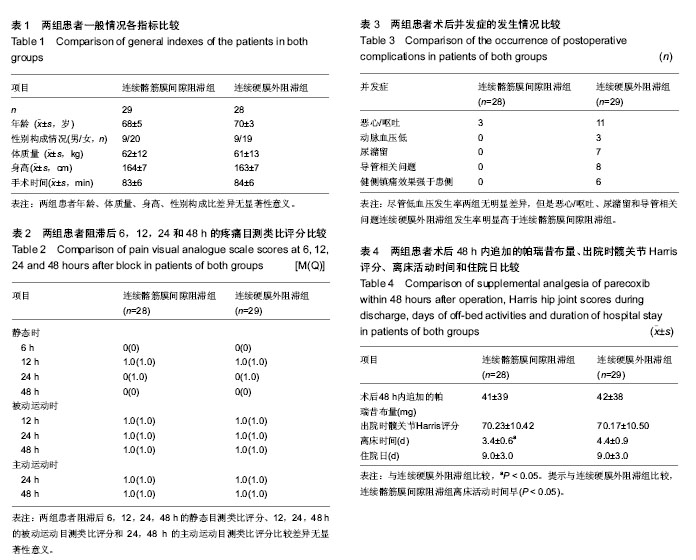| [1] Dulaney-Cripe E, Hadaway S, Bauman R, et al. A continuous infusion fascia iliaca compartment block in hip fracture patients: a pilot study. J Clin Med Res. 2011;4(1):45-48.
[2] Choi PT, Bhandari M, Scott J, et al. Epidural analgesia for pain relief following hip or knee replacement. Cochrane Database Syst Rev. 2003;(3):CD003071.
[3] Fischer HBJ, Simanski CJP. A procedure-specific systematic review and consensus recommendations for analgesia after total hip replacement. Anaesthesia.2005;60(12):1189-1202.
[4] Singelyn FJ, Deyaert M, Jorist D, et al. Effects of intravenous patient-controlled analgesia with morphine, continuous epidural analgesia, and continuous three-in-one block on postoperative pain and knee rehabilitation after unilateral total knee arthroplasty. Anesth Analg. 1998;87:88-92.
[5] Okoro T, Lemmey AB, Maddison P, et al. An appraisal of rehabilitation regimes used for improving functional outcome after total hip replacement surgery. Sports Med Arthrosc Rehabil Ther Technol. 2012; 4: 5.
[6] 庄心良,曾因明,陈伯銮.现代麻醉学(上、下册)[M].3版.北京:人民卫生出版社,2003: 2505-2539.
[7] Busch CA,Shore BJ,Bhandari R, et al. Efficacy of periarticular multimodal drug injection in total Knee arthroplasty: a randomized trial.J Bone Joint Surg Am. 2006;88:959-963.
[8] Farag E,Dilger J,Brooks P,et al. Epidural analgesia improves early rehabilitation after total knee replacement.J Clin Anesth. 2005;17(4): 281-285.
[9] Singelyn FJ, Ferrant T, Malisse MF, et al. Effects of intravenous patient-controlled analgesia with morphine, continuous epidural analgesia, and continuous femoral nerve sheath block on rehabilitation after unilateral total-hip arthroplasty. Reg Anesth Pain Med. 2005;30:452-457.
[10] Glotzbecker MP, Bono CM, Wood KB, et al. Postoperative spinal epidural hematoma: a systematic review. Spine (Phila Pa 1976). 2010;35(10):E413-420.
[11] Chelly JE. Peripheral Nerve Blocks:A Color Atlas. Lippincott Williams & Wilkns. 2008: 93-95.
[12] Dalens B, Vanneuville G, Tanguy A. Comparison of the fascia iliaca compartment block with the 3-in-1 block in children. Anesth Analg.1989;69:705-713.
[13] Capdevila X, Biboulet P, Bouregba M, et al. Comparison of the three-in-one and fascia iliaca compartment blocks in adults: clinical and radiographic analysis. Anesth Analg. 1998; 86:1039-1044.
[14] Murakawa T, Kudo M, Matsuki A, et al. Plasma catecholamine levels following continuous epidural infusion of morphine for postoperative analgesia in surgical patients. Masui.1990; 39(6):728-733.
[15] Kuczkowski KM. Ambulation with combined spinal-epidural labor analgesia: the technique.Acta Anaesthesiol Belg. 2004; 55(1):29-34.
[16] Silvasti M, Pitkänen M.Patient-controlled epidural analgesia versus continuous epidural analgesia after total knee arthroplasty. Acta Anaesthesiol Scand. 2001;45(4):471-476.
[17] Prusinkiewicz C, Lang S, Tsui BC. Lateral cervical epidural catheter placement using nerve stimulation for continuous unilateral upper extremity analgesia following a failed continuous peripheral nerve block. Acta Anaesthesiol Scand. 2005;49(4):579-582.
[18] Buchheit T, Crews JC. Lateral cervical epidural catheter placement for continuous unilateral upper extremity analgesia and sympathetic block.Reg Anesth Pain Med. 2000;25(3): 313-317.
[19] Yamauchi M, Kawaguchi R, Sugino S, et al. Ultrasound-aided unilateral epidural block for single lower-extremity pain. J Anesth. 2009;23(4):605-608. |
